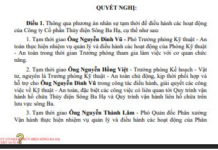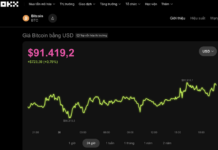
On the morning of April 24, the State Bank announced the central exchange rate at 24,274 VND, a decrease of 1 VND compared to yesterday. This is the first trading session in the last 2 weeks that the SBV has adjusted the central exchange rate down. The immediate selling price of USD by the State Foreign Exchange Reserve Management Department remains at 25,450 VND.
Previously, the central exchange rate had increased sharply, especially from April 15 onwards, which was also the day when the USD price skyrocketed to the ceiling. Specifically, from April 15 to April 23, the central exchange rate increased by 192 VND. At the same time, the USD selling price at banks also increased from 25,180 VND to 25,488 VND.
With a fluctuation range of +/-5%, the floor exchange rate and the ceiling exchange rate applicable to commercial banks on April 24 are 23,061-25,487 VND. Accordingly, bank USD prices also decreased by 1 VND in the early hours of the morning to meet the ceiling requirement.
Specifically, at Vietcombank, the USD price is currently listed at 25,177-25,487 VND, a decrease of 1 VND compared to yesterday. BIDV and VietinBank apply 25,187-25,487 VND and 25,180-25,487 VND respectively.
Similarly, Techcombank also reduced the selling price by 1 VND to 25,487 VND, keeping the buying price at 25,250 VND.
In the free market, the USD price fell by about 50 VND, currently 25,750 VND for buying and 25,850 VND for selling.
Yesterday (April 23), the State Bank made a new move, considered the next step in the effort to control the exchange rate. Specifically, the SBV has injected 36,000 billion VND into the market through lending to 9 members via the OMO channel with a 14-day term. Notably, the winning interest rate has increased to 4.25%/year instead of 4%/year in the past. This is also the highest interest rate on the OMO channel since mid-2023. Accordingly, the scale of lending through the OMO channel reaches a 7-year high.
It is known that, in addition to publicly selling foreign currencies from April 19, the SBV continues to use the credit note channel and OMO in parallel to regulate liquidity and interbank market interest rates, thereby affecting the exchange rate.
The move to increase OMO interest rates is expected to affect VND interest rates in market 2, thereby narrowing the USD – VND interest rate differential in the interbank market without significantly affecting the interest rate level in market 1. Through that, the operator limits USD speculation, reducing pressure on the exchange rate.
In the structure of operating interest rates, OMO interest rates have a strong impact on the market because they are directly and permanently linked to the cost of supporting resources for the system, especially stabilizing in cases where system liquidity needs support.





































